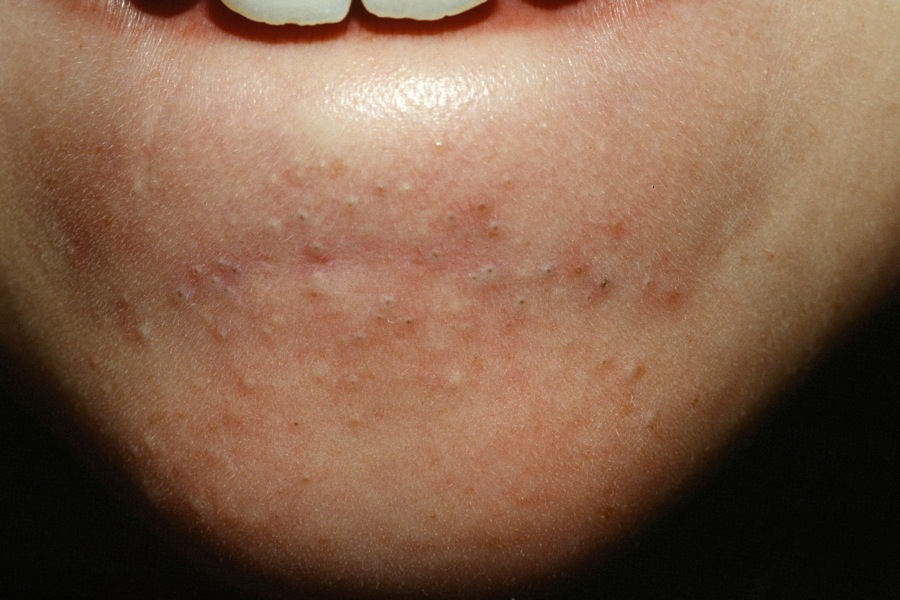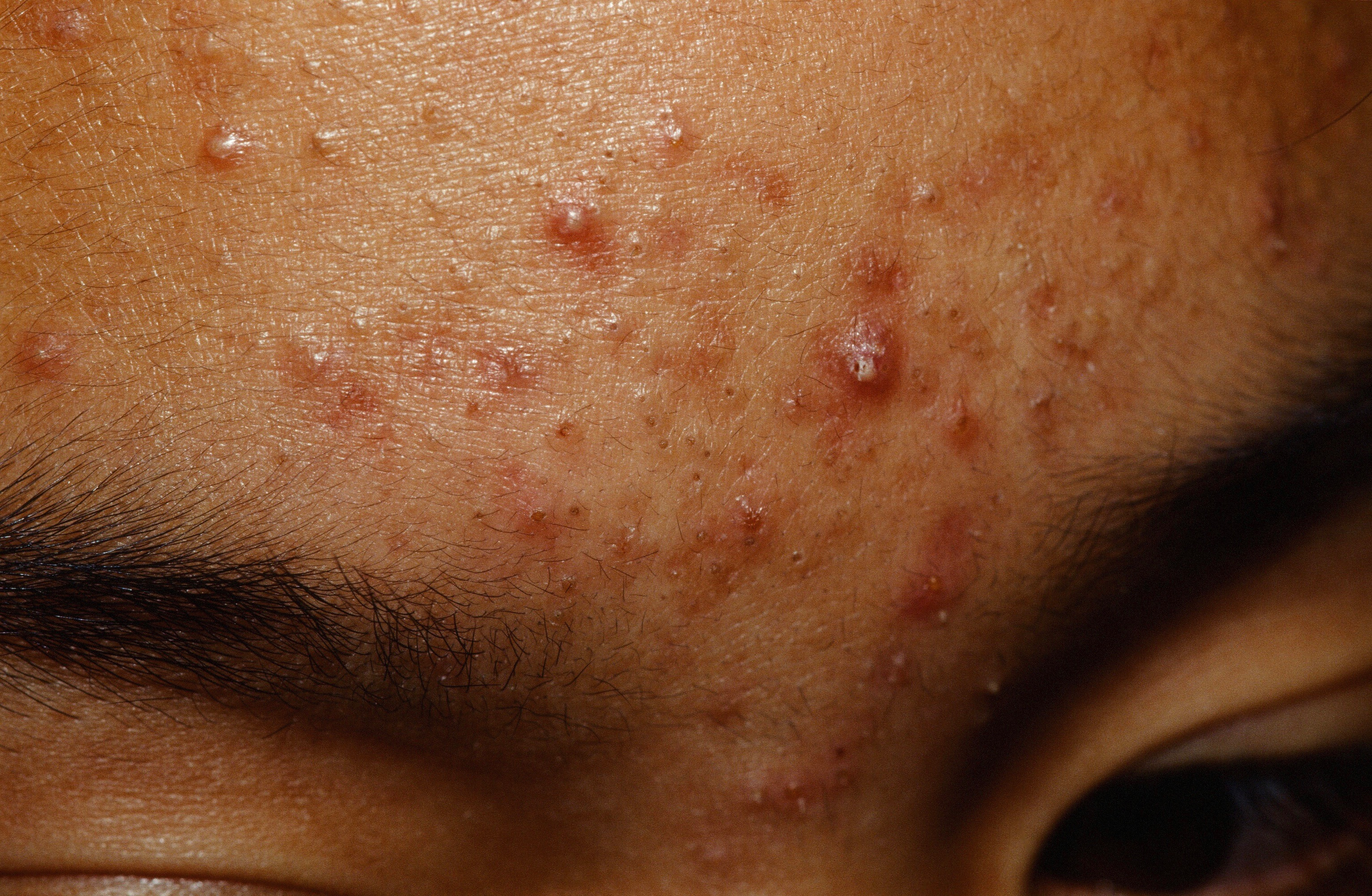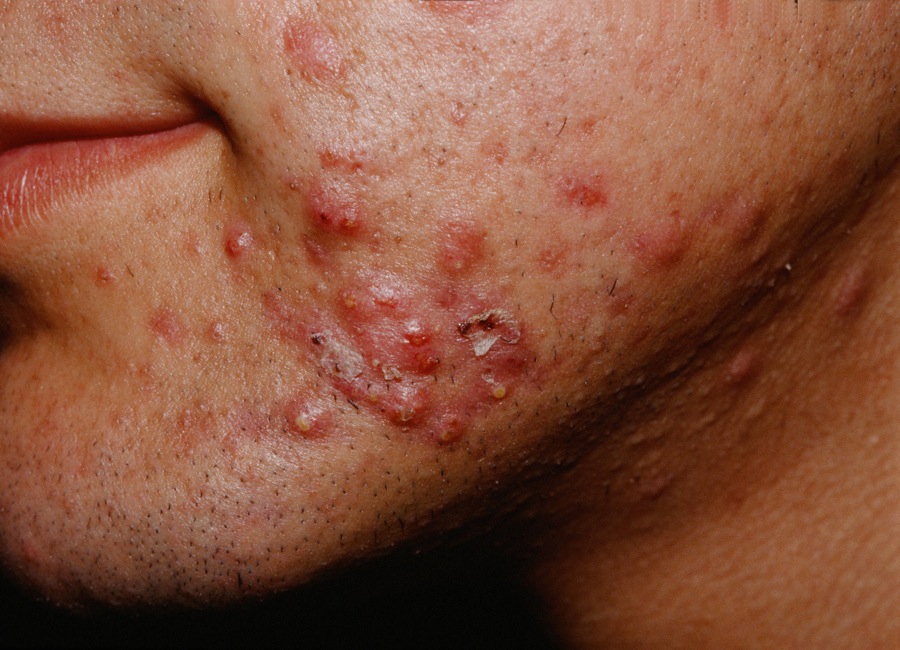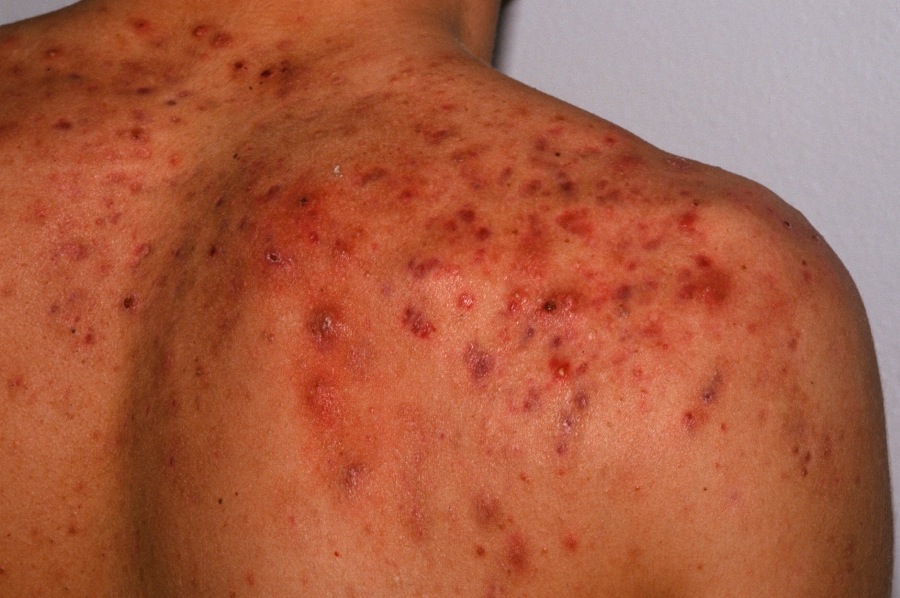ACNE
Acne is one of the most common skin conditions. It affects nearly every teenager as well as many young women. It begins in the prepubertal years (e.g., 8-13 years), peaks around age 16, and for males, usually remits by age 20.
- Unfortunately for women, the acne may persist well into the 20's and even 30's. Furthermore, some women who had very little to no acne before age 20 may develop acne in adulthood. See here for a further discussion of acne in women.
- Onset is earlier now. Acne may be the first sign of onset of puberty in children 7 to 11 years of age.
- Acne is caused by a combination of clogged pores and an infection of the follicles by the bacteria Propionibacterium acnes (P. acnes)--not dirt!
- Acne often leaves a bit of color change as it heals. Many patients think these are scars, but luckily they are not. If the acne is controlled, these color spots will fade. Acne scars, in contrast, are raised, depressed or pitted, with an uneven texture that can be felt. If your acne is scarring, see your dermatologist as soon as possible.
- Truncal acne is often more resistant to treatment and usually requires oral antibiotics and/or isotretinoin.
Is my diet part of the problem?
It could be. A healthy diet is important in the treatment of acne. All of the following have been associated with acne flares and should be minimized: milk (especially skim milk), ice cream, chocolate, sugary drinks, all sweets (anything high glycemic) and whey protein.
Treatment, Brief Overview
There are excellent treatments for all forms of acne. If you have acne and can't control it, see your dermatologist. What follows is a common approach.
If you have sensitive skin, you may want to start with just one product and even every other day use for a week or two. Increase to the daily regimen as tolerated. Give this or any other acne regimen at least 2 months to work.
AM
- Wash your face gently with your hands and a mild soap or gentle cleanser, rinse and pat dry.
- Apply a benzoyl peroxide-containing product all over, where ever you get acne. Make sure to avoid contact with towels, robes, clothing, etc. as BP can bleach.
- Apply a non-comedogenic moisturizer with a sunscreen (at least SPF 30) as needed.
PM
- Wash your face gently to remove the day's oils and makeup.
- Apply a retinoid (adapalene aka Differin, tretinoin, or tazarotene) all over, where ever you get acne.
- Apply a moisturizer if needed.
Differin (adapalene) is the only over-the-counter retinoid and is excellent. (There is a higher concentration available by prescription.) Tretinoin (Retin A) and tazarotene are also commonly used. Some people experience excessive burning with any retinoid initially. To prevent this, you might want to start using every other night and increase to daily as tolerated. Retinol is available OTC but is not as strong for acne as the prescription retinoids.
There are many OTC benzoyl peroxide (BP) products that are excellent for acne (e.g. Clean & Clear persa-gel, Neutrogena and PanOxyl). Select one with 2.5-5% BP to start off with as BP can be drying. The leave-on products are a stronger and are preferred, but the washes can be more convenient. I often prescribe a combination product containing benzoyl peroxide and clindamycin.
Other Key Points
- Wash your face twice a day and no more, unless you exercise/sweat.
- Using a mild soap, e.g. Dove, is absolutely fine, but if you prefer, a gentle cleanser e.g. CeraVe Face Wash Acne Treatment, or Cetaphil Face Wash is great as well. Some cleansers are for oily skin and some for dry. Pick what is best for you. Some cleansers contain salicylic acid which can help as well, as long as it doesn't irritate your skin.
- Don't pick! That often messes up the color of the skin and causes more scarring than the acne itself.
- Don't spot treat. Instead, put the medication all over, wherever you get acne. The goal is to prevent acne and maintain clear skin.
- Make sure anything you put on your face is okay for acne-prone skin. Look for that term "non-comedogenic" or "non-acnegenic" or "oil-free".
- For acne along the hairline, cut back on hair conditioners and don't use 2-in-1 (combined) shampoo and conditioners as these products are notorious for causing this problem.
- Be patient. Give any acne regimen about 2-3 months to work.
- Keep up the treatment, even when you are better.
If you any problem or questions about your acne, please see your dermatologist. If you think your acne is scarring, please do so right away.
Pictures

Comedonal acne (blackheads and whiteheads). Retinoids (e.g. adapalene, tretinoin, tazorotene) are key here to unclogging the pores.
 Inflammatory Acne. Benzoyl peroxide alone or in combination with clindamycin is excellent for the inflammatory papules and pustules of acne (along with a retinoid).
Inflammatory Acne. Benzoyl peroxide alone or in combination with clindamycin is excellent for the inflammatory papules and pustules of acne (along with a retinoid).

More severe acne. This type of acne usually requires pils as well (e.g. doxycycline) and if needed isotretinion.
 Acne on the back. Acne of the trunk is usually more resistant to therapy. Isotretinoin (Accutane) is indicated here.
Acne on the back. Acne of the trunk is usually more resistant to therapy. Isotretinoin (Accutane) is indicated here.
RegionalDerm
Who is Dr. White? | Privacy Policy | FAQs | Use of Images | Contact Dr. White
It is not the intention of RegionalDerm.com to provide specific medical advice, diagnosis or treatment. RegionalDerm.com only intends to provide users with information regarding various medical conditions for educational purposes and will not provide specific medical advice. Information on RegionalDerm.com is not intended as a substitute for seeking medical treatment and you should always seek the advice of a qualified healthcare provider for diagnosis and for answers to your individual questions. Information contained on RegionalDerm.com should never cause you to disregard professional medical advice or delay seeking treatment. If you live in the United States and believe you are having a medical emergency call 911 immediately.


 Inflammatory Acne. Benzoyl peroxide alone or in combination with clindamycin is excellent for the inflammatory papules and pustules of acne (along with a retinoid).
Inflammatory Acne. Benzoyl peroxide alone or in combination with clindamycin is excellent for the inflammatory papules and pustules of acne (along with a retinoid). 
 Acne on the back. Acne of the trunk is usually more resistant to therapy. Isotretinoin (Accutane) is indicated here.
Acne on the back. Acne of the trunk is usually more resistant to therapy. Isotretinoin (Accutane) is indicated here.